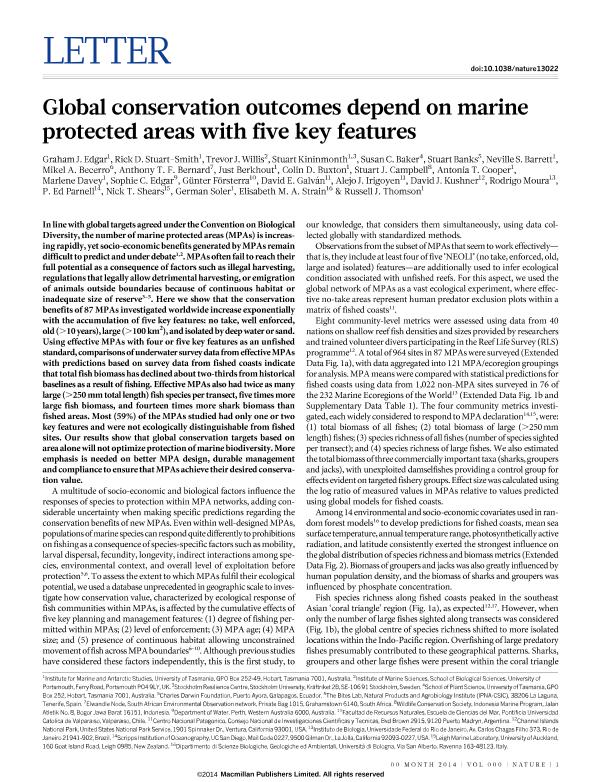Mostrar el registro sencillo del ítem
dc.contributor.author
Graham, J. Edgar
dc.contributor.author
Stuart Smith, Rick D.
dc.contributor.author
Willis, Trevor J.
dc.contributor.author
Kininmonth, Stuart
dc.contributor.author
Baker, Susan C.
dc.contributor.author
Banks, Stuart
dc.contributor.author
Barrett, Neville S.
dc.contributor.author
Becerro, Mikel A.
dc.contributor.author
Bernard, Anthony T. F.
dc.contributor.author
Berkhout, Just
dc.contributor.author
Buxton, Colin D.
dc.contributor.author
Campbell, Stuart J.
dc.contributor.author
Cooper, Antonia T.
dc.contributor.author
Davey, Marlene
dc.contributor.author
Edgar, Sophie C.
dc.contributor.author
Försterra, Günter
dc.contributor.author
Galvan, David Edgardo

dc.contributor.author
Irigoyen, Alejo Joaquin

dc.contributor.author
Kushner, David J.
dc.contributor.author
Moura, Rodrigo
dc.contributor.author
Parnell, P. Ed
dc.contributor.author
Shears, Nick T.
dc.contributor.author
Soler, German
dc.contributor.author
Strain, Elisabeth M. A.
dc.contributor.author
Thomson, Russell J.
dc.date.available
2017-12-14T19:00:50Z
dc.date.issued
2014-02-05
dc.identifier.citation
Graham, J. Edgar; Stuart Smith, Rick D.; Willis, Trevor J.; Kininmonth, Stuart; Baker, Susan C.; et al.; Global conservation outcomes depend on marine protected areas with five key features; Nature Publishing Group; Nature; 506; 5-2-2014; 216-220
dc.identifier.issn
0028-0836
dc.identifier.uri
http://hdl.handle.net/11336/30692
dc.description.abstract
In line with global targets agreed under the Convention on Biological Diversity, the number of marine protected areas (MPAs) is increasing rapidly, yet socio-economic benefits generated by MPAs remain difficult to predict and under debate. MPAs often fail to reach their full potential as a consequence of factors such as illegal harvesting, regulations that legally allow detrimental harvesting, or emigration of animals outside boundaries because of continuous habitat or inadequate size of reserve. Here we show that the conservation benefits of 87 MPAs investigated worldwide increase exponentially with the accumulation of five key features: no take, well enforced, old (>10 years), large (>100km2), and isolated by deep water or sand. Using effective MPAs with four or five key features as an unfished standard, comparisons of underwater survey data from effective MPAs with predictions based on survey data from fished coasts indicate that total fish biomass has declined about two-thirds from historical baselines as a result of fishing. Effective MPAs also had twice as many large (>250mm total length) fish species per transect, five timesmore large fish biomass, and fourteen times more shark biomass than fished areas. Most (59%) of the MPAs studied had only one or two key features and were not ecologically distinguishable from fished sites. Our results show that global conservation targets based on area alone will not optimize protection of marine biodiversity. More emphasis is needed on better MPA design, durable management and compliance to ensure that MPAs achieve their desired conservation value.
dc.format
application/pdf
dc.language.iso
eng
dc.publisher
Nature Publishing Group

dc.rights
info:eu-repo/semantics/openAccess
dc.rights.uri
https://creativecommons.org/licenses/by-nc-sa/2.5/ar/
dc.subject
Marine Protected Areas
dc.subject
Reef
dc.subject
Marine Conservation
dc.subject
Biodiversity
dc.subject.classification
Otras Ciencias Biológicas

dc.subject.classification
Ciencias Biológicas

dc.subject.classification
CIENCIAS NATURALES Y EXACTAS

dc.title
Global conservation outcomes depend on marine protected areas with five key features
dc.type
info:eu-repo/semantics/article
dc.type
info:ar-repo/semantics/artículo
dc.type
info:eu-repo/semantics/publishedVersion
dc.date.updated
2017-07-27T12:31:38Z
dc.journal.volume
506
dc.journal.pagination
216-220
dc.journal.pais
Reino Unido

dc.journal.ciudad
Londres
dc.description.fil
Fil: Graham, J. Edgar. University of Tasmania; Australia
dc.description.fil
Fil: Stuart Smith, Rick D.. University of Tasmania; Australia
dc.description.fil
Fil: Willis, Trevor J.. University of Portsmouth; Reino Unido
dc.description.fil
Fil: Kininmonth, Stuart. University of Tasmania; Australia. Stockholms Universitet; Suecia
dc.description.fil
Fil: Baker, Susan C.. University of Tasmania; Australia
dc.description.fil
Fil: Banks, Stuart. Charles Darwin Foundation; Ecuador
dc.description.fil
Fil: Barrett, Neville S.. University of Tasmania; Australia
dc.description.fil
Fil: Becerro, Mikel A.. Natural Products and Agrobiology Institute; España
dc.description.fil
Fil: Bernard, Anthony T. F.. South African Environmental Observation network; Sudáfrica
dc.description.fil
Fil: Berkhout, Just. University of Tasmania; Australia
dc.description.fil
Fil: Buxton, Colin D.. University of Tasmania; Australia
dc.description.fil
Fil: Campbell, Stuart J.. Wildlife Conservation Society; Estados Unidos
dc.description.fil
Fil: Cooper, Antonia T.. University of Tasmania; Australia
dc.description.fil
Fil: Davey, Marlene. University of Tasmania; Australia
dc.description.fil
Fil: Edgar, Sophie C.. Department of Water; Australia
dc.description.fil
Fil: Försterra, Günter. Pontificia Universidad Católica de Valparaíso; Chile
dc.description.fil
Fil: Galvan, David Edgardo. Consejo Nacional de Investigaciones Científicas y Técnicas. Centro Nacional Patagónico; Argentina
dc.description.fil
Fil: Irigoyen, Alejo Joaquin. Consejo Nacional de Investigaciones Científicas y Técnicas. Centro Nacional Patagónico; Argentina
dc.description.fil
Fil: Kushner, David J.. United States National Park Service; Estados Unidos
dc.description.fil
Fil: Moura, Rodrigo. Universidade Federal do Rio de Janeiro; Brasil
dc.description.fil
Fil: Parnell, P. Ed. University of California at San Diego. Scripps Institution of Oceanography; Estados Unidos
dc.description.fil
Fil: Shears, Nick T.. The University Of Auckland; Nueva Zelanda
dc.description.fil
Fil: Soler, German. University of Tasmania; Australia
dc.description.fil
Fil: Strain, Elisabeth M. A.. Universidad de Bologna; Italia
dc.description.fil
Fil: Thomson, Russell J.. University of Tasmania; Australia
dc.journal.title
Nature

dc.relation.alternativeid
info:eu-repo/semantics/altIdentifier/doi/http://dx.doi.org/10.1038/nature13022
dc.relation.alternativeid
info:eu-repo/semantics/altIdentifier/url/https://www.nature.com/articles/nature13022
Archivos asociados
